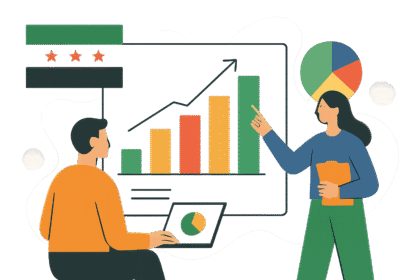
Data Visualization: Why Every Organization in Syria Needs It?
- Data visualization is a tool that enables organizations to easily understand and analyze data.
- The ability of organizations to make informed decisions relies on data visualization, combining data analytics and artificial intelligence.
- Analyzing trends and general behaviors facilitates understanding the Syrian market and assists governmental entities.
- Data visualization contributes to improving internal processes and increasing operational efficiency.
- Challenges in data visualization in Syria present great opportunities for creativity and innovation.
Table of Contents
- What is Data Visualization and How Does It Work?
- Why Does Every Organization in Syria Need Data Visualization?
- Common Types of Data Visualization and Their Importance in the Syrian Context
- Data Visualization and AI: A Partnership for the Future
- Challenges and Opportunities in Data Visualization in Syria
- How Can Insight Syria Help You?
- Conclusion
What is Data Visualization and How Does It Work?
Simply put, data visualization is the process of representing information and data visually, using graphs, charts, maps, and other visual tools. The primary goal is to make complex data easy to understand, highlighting patterns, trends, and outliers that may be hidden in text and tables.
Think of it this way: if you wanted to understand Syria’s economic development over ten years, reading ten tables filled with numbers could be exhausting. But a line graph showing GDP growth or inflation rates over those years gives you an immediate and deep understanding of the phenomenon. This is the magic of data visualization.
The effectiveness of data visualization depends on several key principles:
- Clarity and Conciseness: The visual representation should be simple and focused on the main message.
- Accuracy: The visualizations must accurately reflect the original data without distortion.
- Visual Appeal: Using appropriate colors and shapes makes the data more attractive and easier to remember.
- Context: Providing necessary information to understand the data, such as clear titles, axis labels, and units of measurement.
- Interactivity: In the digital age, interactive visualizations are often the most effective.
Why Does Every Organization in Syria Need Data Visualization?
In the context of data analytics and artificial intelligence, the role of data visualization extends beyond mere display, encompassing strategic decision-making, audience understanding, and performance improvement. Let’s explore the main reasons why data visualization is essential for every organization in Syria:
1. Informed Decision Making:
In a rapidly changing business environment, leaders rely on data to make strategic decisions. Data visualization enables them to quickly see the big picture, identifying potential opportunities and risks.
2. Understanding Consumer and Market Behavior:
For companies and organizations, understanding Syrian market data and consumer behavior is crucial. Data visualization helps in analyzing sales trends and identifying target segments.
3. Improving Internal Processes:
Your ability to enhance operational efficiency relies on data visualization to track key performance indicators (KPIs).
4. Effective Communication with the Audience and Decision Makers:
Data visualization makes information easy to understand and attractive, enhancing the organization’s ability to present its arguments convincingly.
5. Discovering Hidden Patterns and Insights:
Data visualization helps uncover patterns, relationships, and trends that might not be apparent in textual analysis.
6. Supporting the NGO and Public Sector:
Data visualization can aid efforts in tracking, documenting, and improving on all levels.
Common Types of Data Visualization and Their Importance in the Syrian Context
There are many types of data visualization, each with its specific uses and benefits:
- Bar Charts: Ideal for comparing values across different categories.
- Line Graphs: Excellent for showing trends over time.
- Pie Charts: Used to show the proportion of each part of the whole.
- Heat Maps: Useful for visualizing density or spatial distribution.
- Scatter Plots: Show the relationship between two variables.
- Dashboards: Provide an overview of key performance indicators.
Data Visualization and AI: A Partnership for the Future
At Insight Syria, we see data visualization as an integral tool of the data analytics and artificial intelligence ecosystem. Artificial intelligence can process vast amounts of data and discover complex patterns, then present these findings through easy-to-understand data visualizations.
Challenges and Opportunities in Data Visualization in Syria
- Data Availability and Quality: Significant efforts are needed to collect and analyze data accurately.
- Digital Infrastructure: May impact the accessibility of interactive visualizations.
- Specialized Skills: Organizations need experts in this field.
How Can Insight Syria Help You?
At Insight Syria, we have the expertise and capabilities to help you leverage data visualization:
- Data Collection: Through surveys and market research.
- Data Analysis: Using the latest technologies to extract valuable insights.
- Data Visualization: Designing attractive and useful graphics.
- Reporting and Recommendations: Transforming data and insights into actionable reports.
Conclusion
In conclusion, data visualization is a strategic necessity for every organization in Syria striving for success. It supports deep understanding of data and enables effective decision-making. Contact Insight Syria today to find out how we can help you harness the power of data.



